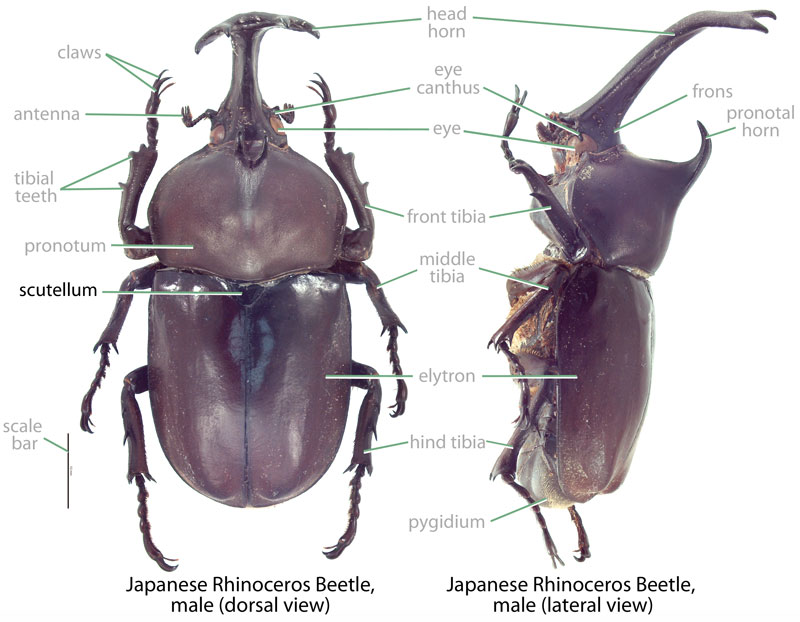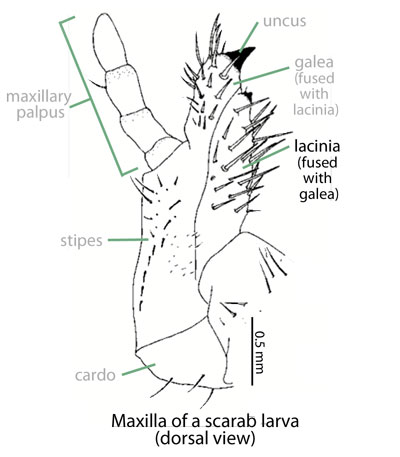Beneficial
coastal dung beetle, black-bottom dung beetle
Family: Scarabaeidae Subfamily: Scarabaeinae Genus: Onthophagus Species: Onthophagus nigriventris D'Orbigny, 1902
none available
Total body length 10.0–17.0 mm (0.39–0.67 in). Body shape oval; may be caked in dung. Color black with greenish cast; elytraelytra:
the hardened and chitinous wing-cover of a beetle that protect and overlie the flight wing
brown. Medium-sized Onthophagus, more than 10 mm. Clypealclypeal:
of, or referring to, the clypeus
apexapex:
point or edge furthest from the body
not strongly produced or reflexedreflexed:
margin that curves upward
in either sex. Major male lacking horns, tubercles, or ridges on head; head of minor male and female with sinuatesinuate:
gently curved (specifically of margins or edges); often in reference to the clypeus
ridge near base. Ocular canthuscanthus:
a process extending over and sometimes dividing the eye
not completely dividing eye. Pronotumpronotum:
the dorsal surface of the thorax
 of major male produced into long, straight horn with smaller bi-lobedbi-lobed:
of major male produced into long, straight horn with smaller bi-lobedbi-lobed:
possessed of two lobe-like structures
process above horn; minor male and female with lobe-like process. Pronotumpronotum:
the dorsal surface of the thorax
 with anterioranterior:
with anterioranterior:
the front or forward; opposite of posterior
angles rounded. Front tibiatibia:
a segment of the leg articulated with the tarsus and femur
 of males somewhat slender and elongate; female tibiatibia:
of males somewhat slender and elongate; female tibiatibia:
a segment of the leg articulated with the tarsus and femur
 comparatively stout. Scutellumscutellum:
comparatively stout. Scutellumscutellum:
the triangular portion of the thorax between the bases of the elytra
 absent.
absent.
Undescribed. For Onthophagus spp. (Ritcher, 1966Ritcher, 1966:
Ritcher P. 1966. White grubs and their allies: a study of North American scarabaeoid larvae. Oregon State University Monographs, Studies in Entomology 4: 1-219.): Grub C-shaped, hump-backed, cylindrical, and cream-colored. Maxillamaxilla:
set of paired mouthparts located posterior to the mandibles
with galeagalea:
outer branch or lobe of the maxilla
 and lacinialacinia:
and lacinialacinia:
inner portion of the maxilla distinctly separate. Epipharynxepipharynx:
distinctly separate. Epipharynxepipharynx:
lobe on the interior surface of the labrum or clypeus
with tormaetormae:
in scarab larvae, sclerotized structures on the ends of the clypeolateral suture extending towards the mesal line
united mesallymesally:
at or near midline of body
, anterioranterior:
the front or forward; opposite of posterior
phoba present. AntennaeAntennae:
paired sensory organ on head, formed from numerous segments
 4-segmented, distaldistal:
4-segmented, distaldistal:
situated away from the point of articulation, thus usually furthest from the body
segment much reduced. Legs 2-segmented. Prothoracic shieldprothoracic shield:
the chitinous plate behind the head of larvae
 without anteriorly projecting processes. Third abdominal segment bearing a prominent conical, dorsaldorsal:
without anteriorly projecting processes. Third abdominal segment bearing a prominent conical, dorsaldorsal:
of or relating to the upper surface; opposite of ventral
gibbosity covered with numerous short, stout setaesetae:
small, hair-like structure
.
East Africa. This species is native to moist highlands in eastern Africa. It also was introduced to Australia (Tyndale-Biscoe, 1990Tyndale-Biscoe, 1990:
Tyndale-Biscoe M. 1990. Common dung beetles in pastures of southeastern Australia. CSIRO Publishing, Clayton, Australia.).
None. This species feeds on dung as both an adult and larvalarva:
the immature form of an insect; in scarabs, also called grub or white grub; preceded by the egg stage, followed by the pupal stage
 . There are no records of this beetle feeding on live plant tissues.
. There are no records of this beetle feeding on live plant tissues.
(Tyndale-Biscoe, 1990Tyndale-Biscoe, 1990:
Tyndale-Biscoe M. 1990. Common dung beetles in pastures of southeastern Australia. CSIRO Publishing, Clayton, Australia.): Adults of this diurnaldiurnal:
active during daylight hours
species live 2–4 months. During that time, adults actively fly in search of fresh dung. Females create oval-shaped brood balls in burrows constructed under or near dung. Development from egg to adult requires 4–7 weeks. There are multiple generations per year.
None. This species recycles dung and is beneficial for ranching and farming in Hawaii. Primarily being a dung feeder, this species has never been recorded damaging crop or ornamental plants. Additionally, this species is not a threat to native dung beetles because none occur in Hawaii or Guam.
Established. In Hawaii, this species was imported in 1975 to Big Island and Maui to combat the horn fly (Haematobia irritans), a biting pest of livestock (Markin and Yoshioka, 1998Markin and Yoshioka, 1998:
Markin G and Yoshioka E. 1998. Biological control of the horn fly, Haematobia irritans L., in Hawai'i (Diptera: Muscidae). Proceedings of the Hawaiian Entomological Society 33: 43-50. full text (accessed 2015)). It is established in the highlands of both islands, being rare on Maui (Krushelnycky et al., 2007Krushelnycky et al., 2007:
Krushelnycky P, Loope L, Gillespie R. 2007. Inventory of arthropods of the west slope shrubland and alpine ecosystems of Haleakala National Park. University of Hawaii at Manoa, Department of Botany. Technical Report. DOI: http://hdl.handle.net/10125/29487) but more common on Big Island (Markin and Yoshioka, 1998Markin and Yoshioka, 1998:
Markin G and Yoshioka E. 1998. Biological control of the horn fly, Haematobia irritans L., in Hawai'i (Diptera: Muscidae). Proceedings of the Hawaiian Entomological Society 33: 43-50. full text (accessed 2015)).
Not established or recorded. There are no records of this species from Guam.
In Hawaii, this species was intentionally imported.
This species could be confused with the similarly colored and medum-sized (more than 10 mm) Digitonthophagus gazella and Onthophagus sagittarius.
Major males are readily separated by examining the head armature (O. nigriventris lacking horns on head versus D. gazellawith 2 short, upward curving horns and O. sagittarius with 2 tusk-like horns).
Minor males and females can be separated by examining base of the head (O. nigriventris with a sinuatesinuate:
gently curved (specifically of margins or edges); often in reference to the clypeus
ridge versus D. gazellawith straight, transversetransverse:
extending horizontally across a surface
ridge versus O. sagittarius with single horn).
none known
Report your observation of this beneficial species at our iNaturalist project.